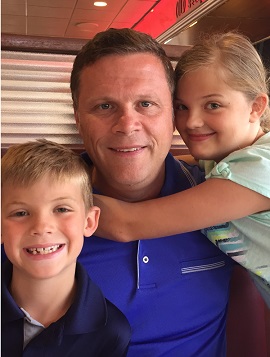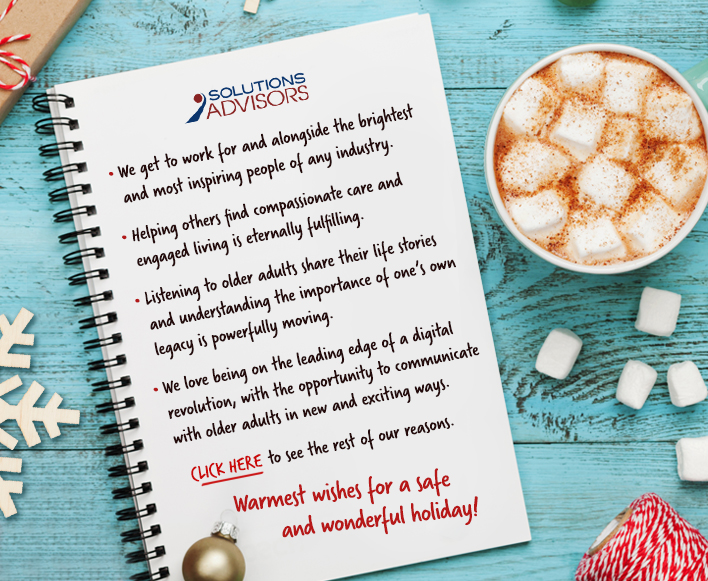Senior VP Mike Brindley Reflects on Selling in the Time of Covid
Leave a Comment Mike Brindley, Senior Vice President of Consulting Services, has been with Solutions Advisors nearly 8 years, having spent over 20 years in operations, sales and marketing and community development for two of the largest providers of senior living. As Senior VP, Mike coaches the Solutions Advisors’ team of sales consultants and advises clients on marketing strategies for existing communities, expansions and startups. We asked Mike how Solutions Advisors has helped communities adapt during the pandemic.
Mike Brindley, Senior Vice President of Consulting Services, has been with Solutions Advisors nearly 8 years, having spent over 20 years in operations, sales and marketing and community development for two of the largest providers of senior living. As Senior VP, Mike coaches the Solutions Advisors’ team of sales consultants and advises clients on marketing strategies for existing communities, expansions and startups. We asked Mike how Solutions Advisors has helped communities adapt during the pandemic.
How has Covid changed the way Solutions Advisors approaches sales and marketing?
In the first few weeks we understood communities were focused on keeping everyone safe – residents and team members. Internally, we took that time to step back and regroup – what can we do differently to help sales teams continue to work in this new environment. How can we help them remotely and still add value? How can we drive leads and conversions without being able to bring prospects on site? We looked at different technology platforms – Zoom, Facebook Live, OneDay – and immediately began to learn these platforms together and push them out to clients. We acted fast, learning as we went.
Our sales consultants had to learn how to have sales meetings and planning sessions via Zoom. Instead of being on site 3 or 4 days a week, now we had daily and weekly phone calls to help sales teams adapt, to use their time more creatively to maintain connections with prospects, and to strategize ways to generate new leads without the benefit of on-site events or the ability to see the community or amenity spaces.
What were some of the new strategies that worked to keep prospects engaged or generate new leads?
We adapted our events strategy to hold webinars or virtual events. Instead of a downsizing event, we held a downsizing webinar. Instead of a resident panel, we held a virtual panel and allowed participants to ask questions via chat. Virtual tours have become popular, although we realized it can’t be just about the community, but about the connection. We partnered with OneDay and trained sales teams how to use short videos to stay connected with prospects. Facebook Live is another resource for small scale events that can get a large reach. We emphasized the importance of frequent social media posts. Once communities realized this was the new normal, they began to get really creative in the way they connected with prospects, using webinars, FaceTime, Zoom meetings and creative follow up. One community even held a drive-by open house. We learned together, we brainstormed and shared ideas and “aha” moments among Solutions Advisors consultants on weekly calls so they in turn could share with clients.
What’s been successful?
Communities that have adapted new technology platforms like One Day to stay connected have been the most successful in keeping prospects in the pipeline or advancing prospects to the thinking or planning stage. Using OneDay we saw the value of building a genuine connection using video versus an email or phone conversation. Even if you cannot have tours or move-ins right now, eventually you will reap the benefits of keeping prospects engaged.
We’ve identified some interesting trends. For example, we’re seeing more influencers involved in the independent living decision – more like assisted living. The adult children want to know mom’s going to be safe and comfortable at your community and feel confident about your community’s safety measures and protocols. They’re more involved, asking more questions, doing the research. So, we’ve started to look at strategies to communicate with the influencer while respecting the control of the decision with the potential resident.
Our digital team has been in the forefront of identifying ways to use platforms like Facebook Live and social media to engage audiences and has pushed strategies like SEO, PPC, Google and Facebook ads to make websites more effective in driving leads and conversions. And, somewhat ironically, some markets are responding to the more traditional mediums like print advertising. People are at home more, reading more, listening to news about Covid. So, we are using at both traditional and non-traditional channels to communicate with different audiences.
What are three top things you would share with sales teams during this time?
One, it’s more important than ever to create the connection with the prospect, to listen and understand their story. Ask good questions. Not, ‘what are you looking for,’ but ‘how are you feeling?’ Develop trust with the prospect, try to dispel their fear and anxiety. It may not be a decision they are ready to make now, but if they trust you, they’ll come back to you.
Two, be creative in a genuine way. Introduce yourself via Zoom. Develop a fun video about yourself using OneDay. Maybe they have a dog and you do too, or grandkids, or you share a fondness for reading or crossword puzzles – celebrate whatever creates that connection. Maybe make a short video testimonial from a resident who felt safe and cared about during the pandemic. Use the time you have now to be creative in your approach.
Three, I respect and applaud our communities for their focus on keeping team members and residents safe. Several have been Covid free or have only one or two cases. That will become important down the road when residents are able to say, “Yes, we were quarantined but we had everything we needed and felt safer here than at home.” Be transparent, answer prospects’ questions about what you are doing differently now. But be real, be honest. Don’t show a dining room full of people if that’s not the reality right now. Show the outstanding customer service as team members deliver meals door to door, show outdoor dining with social distancing, show how you are keeping residents and team members safe while delivering needed services. Communities that are very transparent about what’s going on will win the day.
Are you optimistic about the future of senior living?
Look, our older population has been through a lot in their lives, from the depression, several wars, the recession, and now the pandemic. They are a resilient generation and we can learn a lot from them. It’s more important than ever to listen to their stories. We need to be adaptable and fluid. In several of our communities, people are still putting down deposits for the future, still moving, still seeing the value in the environment and services we offer. We need them and they need us. We’ll figure this out together.
Any closing thoughts?
Well, as we are talking, I’m driving to a community to meet with the sales team. While we’ve done a good job of staying connected through technology, I have to say it’s fantastic to see people face to face again, to have that human connection, even while six feet away and wearing masks. I guess my closing thought would be not to lose that sense of humanity. It may be a cliché by now, but we truly are all in this together.

 The COVID-19 pandemic has forced many to turn to online resources to meet every-day needs, from work meetings to happy hours to shopping for groceries. And while some people were already natives of the digital landscape, this is a strange and unfamiliar place to many, especially older adults.
The COVID-19 pandemic has forced many to turn to online resources to meet every-day needs, from work meetings to happy hours to shopping for groceries. And while some people were already natives of the digital landscape, this is a strange and unfamiliar place to many, especially older adults.